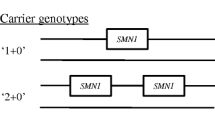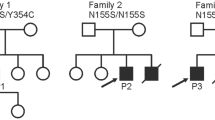Abstract
PROXIMAL spinal muscular atrophies represent the second most common fatal, autosomal recessive disorder after cystic fibrosis1. The childhood form is classically subdivided into three groups: acute Werdnig-Hoffmann (type I), intermediate Werdnig-Hoffmann disease (type II) and Kugelberg-Welander disease (type III). These different clinical forms have previously been attributed to either genetic heterogeneity or variable expression of different mutations at the same locus2. Research has been hindered because the underlying biochemical defect is unknown, and there are insufficient large pedigrees with the most common and severe form (type I) available for study. Therefore, we have undertaken a genetic linkage analysis of the chronic forms of the disease (types II and III) as an initial step towards the ultimate goal of characterizing the gene(s) responsible for all three types. We report here the assignment of the locus for the chronic forms to the long arm of chromosome 5 (5q 12–ql4), with the anonymous DNA marker D5S39, in 24 multiplex families of distinct ethnic origin. Furthermore, no evidence for genetic heterogeneity was found for types II and III in our study, suggesting that these two forms are allelic disorders.
Similar content being viewed by others
References
Pearn, J. Lancet i, 919–922 (1980).
Emery, A. E. H. J. med. Genet. 8, 481–495 (1971).
Hausmanowa-Petrusewicz, I., Zaremba, J. A. & Borkowska, J. J. med. Genet. 22, 350–353 (1985).
Dubowtiz, V. Brain 87, 707–718 (1964).
Morton, N. E. Am. J. hum. Genet. 7, 277–318 (1955).
Leppert, M. et al. Cytogenet. Cell Genet. 46, 649 (1987).
Lathrop, G. M., Lalouel, J. M., Julier, C. & Ott, J. Proc. natn. Acad. Sci. U.S.A. 81, 3443–3446 (1984).
Duchen, L. W., Falconer, D. S. & Strich, S. J. J. Physiol., Lond. 183, 53–55 (1966).
Murakami, T., Mastaglia, F. L., Mann, D. M. A. & Bradley, W. G. Muscle & Nerve 4, 407–412 (1981).
Author information
Authors and Affiliations
Rights and permissions
About this article
Cite this article
Melki, J., Abdelhak, S., Sheth, P. et al. Gene for chronic proximal spinal muscular atrophies maps to chromosome 5q. Nature 344, 767–768 (1990). https://doi.org/10.1038/344767a0
Received:
Accepted:
Issue Date:
DOI: https://doi.org/10.1038/344767a0
- Springer Nature Limited
This article is cited by
-
Spinal Muscular Atrophy Modeling and Treatment Advances by Induced Pluripotent Stem Cells Studies
Stem Cell Reviews and Reports (2019)
-
Efficacy and biodistribution analysis of intracerebroventricular administration of an optimized scAAV9-SMN1 vector in a mouse model of spinal muscular atrophy
Molecular Therapy - Methods & Clinical Development (2016)
-
Early onset muscle weakness and disruption of muscle proteins in mouse models of spinal muscular atrophy
Skeletal Muscle (2013)
-
Single-sperm analysis for recurrence risk assessment of spinal muscular atrophy
European Journal of Human Genetics (2010)





